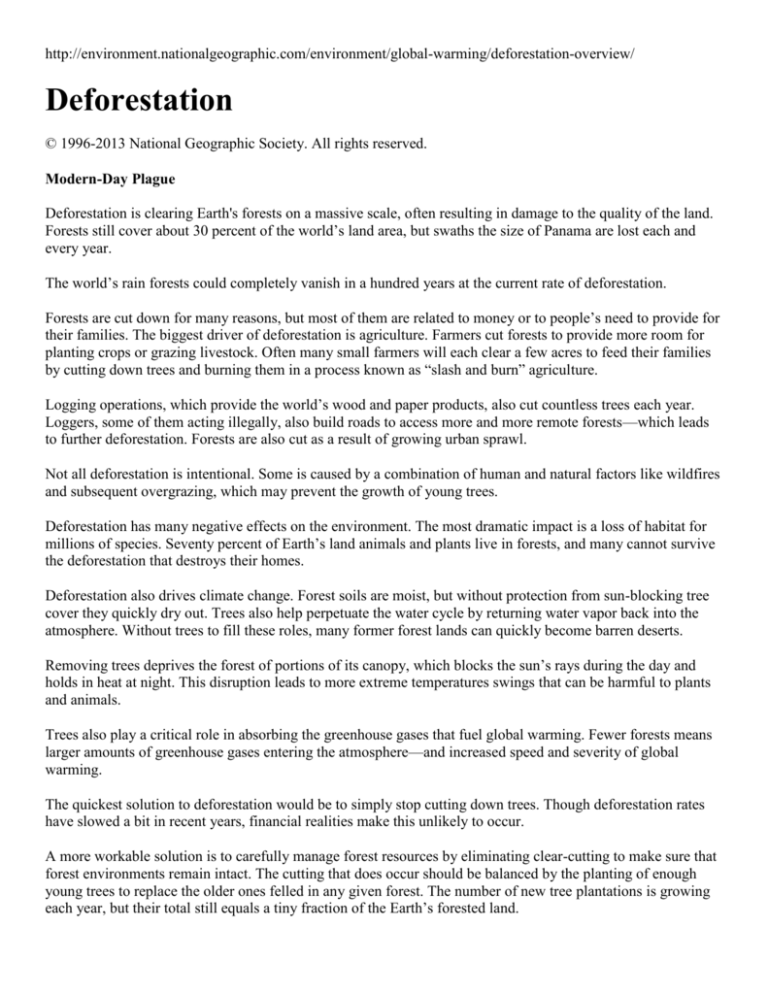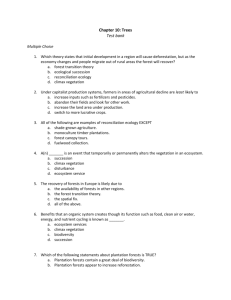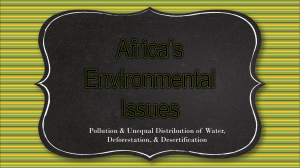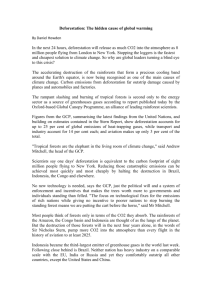
http://environment.nationalgeographic.com/environment/global-warming/deforestation-overview/
Deforestation
© 1996-2013 National Geographic Society. All rights reserved.
Modern-Day Plague
Deforestation is clearing Earth's forests on a massive scale, often resulting in damage to the quality of the land.
Forests still cover about 30 percent of the world’s land area, but swaths the size of Panama are lost each and
every year.
The world’s rain forests could completely vanish in a hundred years at the current rate of deforestation.
Forests are cut down for many reasons, but most of them are related to money or to people’s need to provide for
their families. The biggest driver of deforestation is agriculture. Farmers cut forests to provide more room for
planting crops or grazing livestock. Often many small farmers will each clear a few acres to feed their families
by cutting down trees and burning them in a process known as “slash and burn” agriculture.
Logging operations, which provide the world’s wood and paper products, also cut countless trees each year.
Loggers, some of them acting illegally, also build roads to access more and more remote forests—which leads
to further deforestation. Forests are also cut as a result of growing urban sprawl.
Not all deforestation is intentional. Some is caused by a combination of human and natural factors like wildfires
and subsequent overgrazing, which may prevent the growth of young trees.
Deforestation has many negative effects on the environment. The most dramatic impact is a loss of habitat for
millions of species. Seventy percent of Earth’s land animals and plants live in forests, and many cannot survive
the deforestation that destroys their homes.
Deforestation also drives climate change. Forest soils are moist, but without protection from sun-blocking tree
cover they quickly dry out. Trees also help perpetuate the water cycle by returning water vapor back into the
atmosphere. Without trees to fill these roles, many former forest lands can quickly become barren deserts.
Removing trees deprives the forest of portions of its canopy, which blocks the sun’s rays during the day and
holds in heat at night. This disruption leads to more extreme temperatures swings that can be harmful to plants
and animals.
Trees also play a critical role in absorbing the greenhouse gases that fuel global warming. Fewer forests means
larger amounts of greenhouse gases entering the atmosphere—and increased speed and severity of global
warming.
The quickest solution to deforestation would be to simply stop cutting down trees. Though deforestation rates
have slowed a bit in recent years, financial realities make this unlikely to occur.
A more workable solution is to carefully manage forest resources by eliminating clear-cutting to make sure that
forest environments remain intact. The cutting that does occur should be balanced by the planting of enough
young trees to replace the older ones felled in any given forest. The number of new tree plantations is growing
each year, but their total still equals a tiny fraction of the Earth’s forested land.
http://www.botany.uwc.ac.za/envfacts/facts/deforestation.htm
Created and maintained by: Jocelyn
Collins
Last Updated: February 1, 2001
Deforestation is the permanent destruction of indigenous forests and woodlands. The term does not
include the removal of industrial forests such as plantations of gums or pines. Deforestation has
resulted in the reduction of indigenous forests to four-fifths of their pre-agricultural area. Indigenous
forests now cover 21% of the earth's land surface.
WHAT ARE FORESTS AND WOODLANDS?
In a forest the crowns of individual trees touch to form a single canopy. In woodlands, trees grow far
apart, so that the canopy is open.
GOING, GOING GONE!
Of great concern is the rate at which deforestation is occurring. Currently, 12 million hectares of forests
are cleared annually - an area 1,3 times the size of KwaZulu/Natal! Almost all of this deforestation
occurs in the moist forests and open woodlands of the tropics. At this rate all moist tropical forest could
be lost by the year 2050, except for isolated areas in Amazonia, the Zaire basin, as well as a few
protected areas within reserves and parks. Some countries such as Ivory Coast, Nigeria, Costa Rica, and
Sri Lanka are likely to lose all their tropical forests by the year 2010 if no conservation steps are taken.
HOW DOES IT HAPPEN?
Deforestation is brought about by the following:
* conversion of forests and woodlands to agricultural land to feed growing numbers of people;
* development of cash crops and cattle ranching, both of which earn money for tropical countries;
* commercial logging (which supplies the world market with woods such as meranti, teak, mahogany
and ebony) destroys trees as well as opening up forests for agriculture;
* felling of trees for firewood and building material; the heavy lopping of foliage for fodder; and heavy
browsing of saplings by domestic animals like goats.
To compound the problem, the poor soils of the humid tropics do not support agriculture for long. Thus
people are often forced to move on and clear more forests in order to maintain production.
CONSEQUENCES OF DEFORESTATION
* Alteration of local and global climates through disruption of:
a) The carbon cycle. Forests act as a major carbon store because carbon dioxide (CO2) is taken up from
the atmosphere and used to produce the carbohydrates, fats, and proteins that make up the tree. When
forests are cleared, and the trees are either burnt or rot, this carbon is released as CO2. This leads to an
increase in the atmospheric CO2 concentration. CO2 is the major contributor to the greenhouse effect.
It is estimated that deforestation contributes one-third of all CO2 releases caused by people.
b) The water cycle. Trees draw ground water up through their roots and release it into the atmosphere
(transpiration). In Amazonia over half of all the water circulating through the region's ecosystem
remains within the plants. With removal of part of the forest, the region cannot hold as much water.
The effect of this could be a drier climate.
* Soil erosion With the loss of a protective cover of vegetation more soil is lost.
* Silting of water courses, lakes and dams This occurs as a result of soil erosion.
* Extinction of species which depend on the forest for survival. Forests contain more than half of all
species on our planet - as the habitat of these species is destroyed, so the number of species declines
(see Enviro Facts "Biodiversity").
* Desertification The causes of desertification are complex, but deforestation is one of the contributing
factors (see Enviro Facts "Desertification")
DID YOU KNOW?
* The World Resources Institute regards deforestation as one of the world's most pressing land-use
problems.
* An area of forest equal to 20 football or rugby fields is lost every minute.
* South Africa's climate is such that less than 0,5% of its surface area is covered with indigenous forest
- great care should be taken to conserve the little we have.
Deforestation: Facts, Causes & Effects
Jessie Szalay, LiveScience Contributor | March 06, 2013 04:20pm ET
http://www.livescience.com/27692-deforestation.html
Location
Deforestation occurs around the world, though tropical rainforests are particularly targeted. Countries with
significant deforestation currently or in the recent past include Brazil, Indonesia, Thailand, the Democratic
Republic of Congo and other parts of Africa, and parts of Eastern Europe, according to GRID-Arendal, a United
Nations Environment Program collaborating center.
Though deforestation has increased rapidly in the last 50 years, it has been practiced throughout history. For
example, since 1600, 90 percent of continental United States’ indigenous forest has been removed. The World
Resources Institute estimates that most of the world’s remaining indigenous forest — about 22 percent of its
original amount — is located in Canada, Alaska, Russia, and the Northwestern Amazon basin. The Amazon is a
highly targeted area of recent deforestation.
Causes of deforestation
Deforestation is typically done to make more land available for housing and urbanization, timber, large scale
cash crops such as soy and palm oil, and cattle ranching. The World Wildlife Fund reports that much of the
logging industry that contributes to deforestation is done illegally (about half of it used for firewood).
Common methods of deforestation are burning trees and clear cutting, which is the controversial practice of
complete removal of a given tract of forest. A forestry expert quoted by the Natural Resources Defense Council
describes clear cutting as "an ecological trauma that has no precedent in nature except for a major volcanic
eruption."
Burning can be done quickly, in vast swaths of land for plantation use, or more slowly with the slash-and-burn
technique. This destructive practice entails cutting down a patch of trees, burning them, and growing crops on
the land until the soil becomes too degraded from overgrazing and sun exposure for new growth. Then, the
farmers move on to a new patch of land.
A cleared forest in Riau province, Sumatra, Indonesia.
Credit: © Alain Compost / WWF-Canon.
Effects of deforestation
Forests are complex ecosystems that are important to the carbon and water cycles that sustain life on earth.
When they are degraded, it can set off a devastating chain of events both locally and around the world.
Loss of Species: Seventy percent of the world’s plants and animals live in forests and are losing their habitats to
deforestation. Loss of habitat can lead to species extinction. This is not only a biodiversity tragedy but also has
negative consequences for medicinal research and local populations who rely on the animals and plants in the
forests for hunting and medicine.
Carbon Emissions: Healthy forests help absorb greenhouse gasses and carbon emissions that are caused by
human civilization and contribute to global climate change. Without trees, more carbon and greenhouse gasses
enter the atmosphere. To make matters worse, trees actually become carbon sources when they are cut, burned,
or otherwise removed. “Tropical forests hold more than 210 gigatons of carbon, and deforestation represents
around 15 percent of greenhouse gas emissions,” according to the WWF.
Water Cycle: Trees play an important part in the water cycle, grounding the water in their roots and releasing it
into the atmosphere. In the Amazon, more than half the water in the ecosystem is held within the plants.
Without the plants, the climate may become dryer.
Soil Erosion: Without tree roots to anchor the soil and with increased exposure to sun, the soil can dry out,
leading to problems like increased flooding and inability to farm. The WWF states that scientists estimate that a
third of the world’s arable land has been lost to deforestation since 1960. Cash crops planted after clear cutting
or burning — like soy, coffee, and palm oil — can actually exacerbate soil erosion because their roots cannot
hold onto the soil the way trees’ can.
Life Quality: Soil erosion can also lead to silt entering the lakes, streams, and other water sources. This can
decrease local water quality, contributing to poor health in the local population.
All of these factors can have adverse effects on local economies. Increased flooding, lack of quality water, and
inability to produce their own food causes many locals migrate to cities that lack infrastructure for them. Or,
they work on plantations, worsening the deforestation problem and at times being subjected to inhumane
working conditions.










